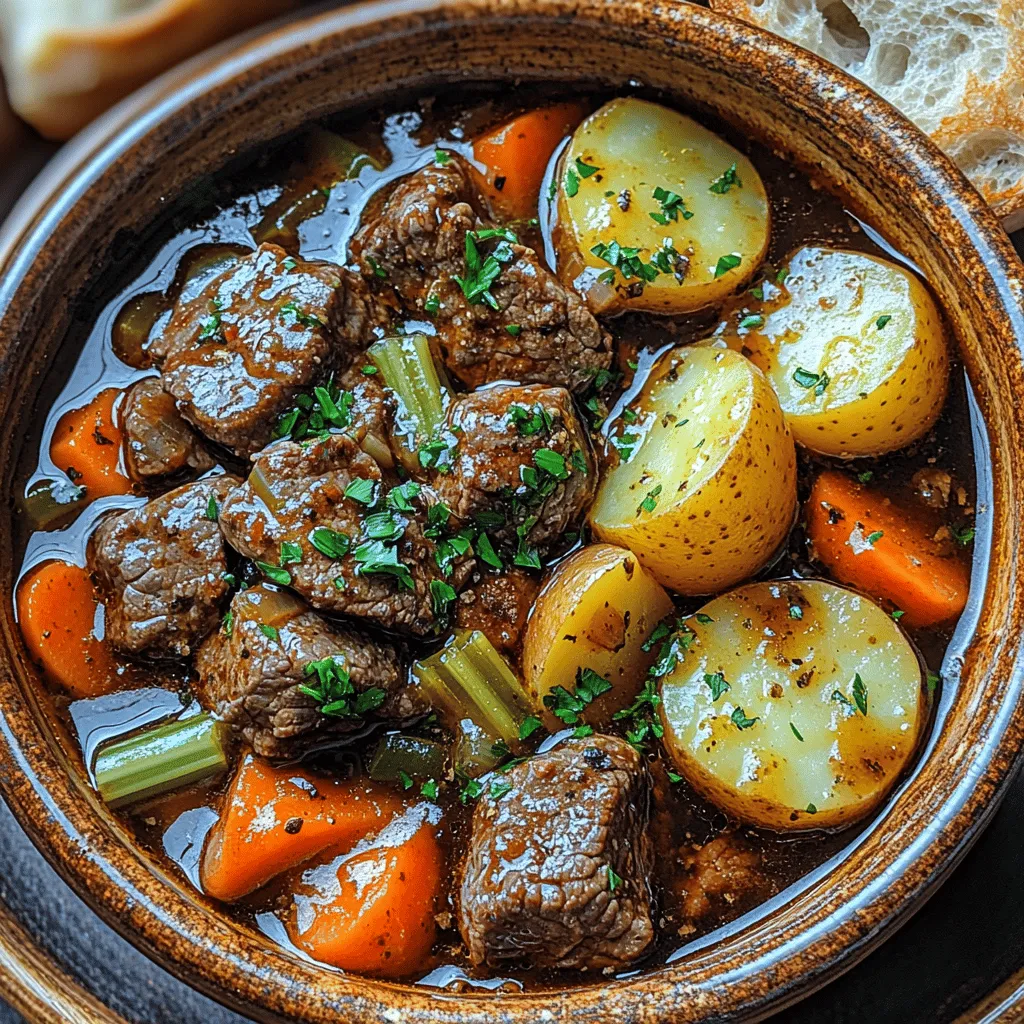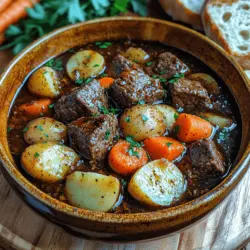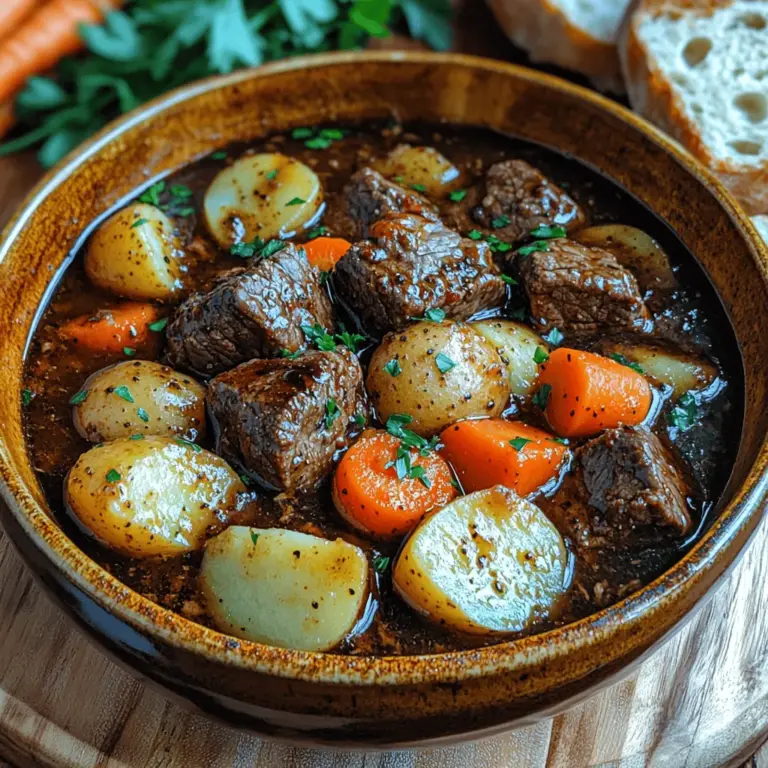Introduction
When the temperature drops and the days grow shorter, there’s nothing quite like a hearty bowl of beef stew to warm your soul. The Savory Balsamic Bliss Beef Stew is an exceptional choice for a comforting meal that not only satisfies hunger but also introduces a symphony of flavors that dance on your palate. This stew combines the rich, succulent taste of beef with the unique tanginess of balsamic vinegar, creating a dish that is both comforting and sophisticated.
Beef stew has long been a staple in kitchens around the world, cherished for its ability to bring families together over a nourishing meal. What sets this particular recipe apart is the use of balsamic vinegar, which enhances the stew’s depth with its sweet and slightly tart flavor profile. This ingredient not only tenderizes the beef but also adds complexity, elevating the stew from a simple comfort food to a culinary delight.
One of the greatest advantages of this Savory Balsamic Bliss Beef Stew is the convenience of slow cooking. Perfect for busy days, you can prepare it in the morning and let it simmer away while you attend to your daily activities. By the time you return home, the aroma of the stew will fill your kitchen, inviting you to gather around the table for a warm, satisfying dinner.
Understanding the Ingredients
To craft a truly satisfying Savory Balsamic Bliss Beef Stew, it is essential to understand the key ingredients that contribute to its rich flavor and heartiness. Each element plays a vital role in building the stew’s character and nutritional value.
Beef Chuck
At the heart of this stew is beef chuck, a cut renowned for its rich flavor and ideal texture when slow-cooked. Beef chuck comes from the shoulder of the cow and contains a good amount of connective tissue and marbling. This means that as it cooks slowly, it breaks down beautifully, resulting in tender, melt-in-your-mouth bites of beef. The fat content not only enhances the flavor but also provides a wonderful mouthfeel, making each spoonful a delight. Choosing high-quality beef chuck is crucial for achieving the best results, so look for cuts that are bright red and marbled with fat.
Balsamic Vinegar
Balsamic vinegar is the star ingredient that brings a unique twist to this traditional stew. Known for its deep, complex flavor, balsamic vinegar adds a subtle sweetness and acidity that balances the richness of the beef. This vinegar also helps to tenderize the meat while infusing the stew with a rich depth that is simply irresistible. When selecting balsamic vinegar for this recipe, choose a high-quality variety that is aged, as it will have a more robust flavor. The vinegar also serves as a natural preservative, which means your stew will maintain its flavor and freshness longer.
Vegetables
The vegetables in this Savory Balsamic Bliss Beef Stew are not merely a garnish; they are essential for building flavor and enhancing the nutritional profile of the dish. Onions and garlic form the aromatic base, creating a fragrant foundation that sets the tone for the entire stew. Carrots add natural sweetness and a lovely pop of color, while celery provides an earthy undertone and crunch. Baby potatoes are perfect for this recipe, as they hold their shape during cooking, offering a hearty texture that complements the tender beef. Together, these vegetables create a well-rounded stew that is both satisfying and wholesome.
Herbs and Spices
No stew is complete without a harmonious blend of herbs and spices, and this recipe features thyme, rosemary, and bay leaf to elevate the flavor profile to new heights. Thyme is a classic herb that pairs beautifully with beef, providing a subtle earthiness that enhances the overall taste. Rosemary adds a fragrant, pine-like aroma that complements the richness of the meat. Bay leaves contribute a depth of flavor that is often described as herbal and slightly floral. These herbs work together to create a beautifully aromatic stew, making it a pleasure to savor each bite.
Preparation Process
With a solid understanding of the ingredients, it’s time to dive into the preparation process for the Savory Balsamic Bliss Beef Stew. Each step is designed to maximize flavor and ensure a delightful final dish.
Searing the Beef
The first step in creating a deeply flavorful stew is to properly sear the beef. Searing is a cooking technique that involves browning the meat over high heat, which caramelizes the surface and deepens the flavor. This process creates a beautiful crust that not only enhances the taste but also adds visual appeal to the finished dish.
Step-by-Step Guide on How to Properly Sear the Beef
1. Prepare the Beef: Start by cutting the beef chuck into 1 to 1.5-inch cubes. This size is ideal for even cooking and ensures that each piece becomes tender and flavorful. Pat the beef dry with paper towels to remove excess moisture, as this will help achieve a good sear.
2. Season Generously: Liberally season the beef cubes with salt and freshly ground black pepper. This simple seasoning will enhance the natural flavors of the meat and provide a delicious base for the stew.
3. Heat the Pan: In a large, heavy-bottomed skillet or Dutch oven, heat a couple of tablespoons of vegetable oil over medium-high heat until shimmering. The oil should be hot but not smoking, which is key to achieving a good sear.
4. Sear in Batches: Add the seasoned beef cubes to the pan in a single layer, making sure not to overcrowd the pan. Searing in batches allows the beef to brown evenly. Cook the beef for about 3-4 minutes on each side, or until a deep brown crust forms. Avoid moving the beef too much during this process, as this will hinder browning.
5. Remove and Set Aside: Once the beef is well-browned, remove it from the pan and set it aside on a plate. Repeat the searing process for any remaining beef cubes, adding more oil to the pan as necessary.
Combining Ingredients
Once the beef is seared to perfection, it’s time to combine all the ingredients in the slow cooker. This step is crucial for layering flavors and ensuring that each component of the stew melds beautifully during the cooking process.
Detailed Instructions on Layering Flavors in the Slow Cooker
1. Start with Aromatics: Begin by adding the chopped onions and minced garlic to the bottom of the slow cooker. These aromatics will release their flavors as they cook, forming a flavorful base for your stew.
2. Add the Vegetables: Next, layer in the chopped carrots, diced celery, and halved baby potatoes. These vegetables will contribute both flavor and texture, absorbing the savory broth as they cook.
3. Return the Beef: Now, add the seared beef back into the slow cooker, distributing it evenly over the vegetables. This ensures that the beef and veggies cook together, allowing the flavors to blend.
4. Pour in the Liquids: In a separate bowl, combine the balsamic vinegar, beef broth, and any additional seasonings you desire. Pour this mixture over the beef and vegetables in the slow cooker. The liquid will help to deglaze the pan, lifting all the flavorful bits that may have stuck to the bottom during the searing process.
5. Herbs and Spices: Finally, add the sprigs of thyme, rosemary, and bay leaves to the slow cooker. These herbs will infuse the stew with their aromatic qualities, creating a delightful fragrance that fills your kitchen.
6. Give it a Stir: Gently stir everything together to combine the ingredients, ensuring that the beef is submerged in the liquid. This step helps to distribute the flavors evenly throughout the stew.
Discussing the Order of Adding Ingredients
The order in which you add ingredients to the slow cooker significantly affects how the flavors meld during cooking. By starting with the aromatics and layering in the vegetables before adding the beef and liquid, you create a foundation that allows each ingredient to impart its flavor into the stew. The seared beef, when placed on top of the vegetables, will release its juices, which will mix with the balsamic vinegar and broth, creating a rich and harmonious flavor profile. This method ensures that every spoonful of stew is a perfect balance of meat, vegetables, and seasoning.
Cooking Techniques
When it comes to cooking methods, the choice between slow cooking and fast cooking can dramatically influence the final dish. For the Savory Balsamic Bliss Beef Stew, slow cooking is the secret to achieving the tender, flavorful result that makes this dish a classic favorite.
Slow Cooking vs. Fast Cooking
– Slow Cooking: As the name implies, slow cooking involves cooking food at low temperatures over an extended period. This method is ideal for tougher cuts of meat, such as beef chuck, as it allows the connective tissues to break down, resulting in tender, juicy beef. The prolonged cooking time also allows the flavors to develop and meld together, creating a rich and satisfying stew. With slow cooking, you can expect the beef to become fork-tender and the vegetables to absorb the savory broth, resulting in a comforting dish that is perfect for chilly evenings.
– Fast Cooking: On the other hand, fast cooking methods, such as sautéing or pressure cooking, can yield quicker results but often sacrifice depth of flavor. While these methods can produce a tasty stew in a fraction of the time, they may not achieve the same level of tenderness or richness as slow cooking. Fast cooking can lead to tougher meat and vegetables that lack the ability to absorb the complex flavors of the broth fully. For a stew like the Savory Balsamic Bliss Beef Stew, slow cooking is the preferred technique to ensure a deeply satisfying meal.
By understanding the preparation process and the significance of slow cooking, you will be well-equipped to create a Savory Balsamic Bliss Beef Stew that is truly exceptional. The combination of quality ingredients, proper cooking techniques, and careful attention to flavor layering will result in a hearty dish that your family will love, making it a go-to recipe for years to come.

Benefits of Slow Cooking for Busy Lifestyles and Flavor Enhancement
In today’s fast-paced world, finding time to prepare wholesome meals can be a challenge. This is where slow cooking comes into play, making it an ideal method for busy individuals and families. Slow cooking allows you to set your ingredients in a pot, forget about them for several hours, and return to a richly flavored dish that’s ready to serve.
One of the key benefits of slow cooking is the way it enhances flavors. As the ingredients simmer together over a longer period, they meld and develop a depth of flavor that’s hard to achieve with quicker cooking methods. The gradual cooking process allows tough cuts of beef to break down and become tender, while vegetables release their natural sugars, creating a delicious balance of savory and sweet notes. This results in a comforting bowl of Savory Balsamic Bliss Beef Stew that warms the soul.
Adjusting Cooking Times: How to Modify for Different Schedules While Ensuring Optimal Tenderness
Slow cooking is versatile, accommodating various schedules with ease. The standard cooking time for beef stew in a slow cooker typically ranges from 6 to 8 hours on low heat or 3 to 4 hours on high heat. However, you can adjust these times based on your needs without sacrificing tenderness.
If you find yourself short on time, you can opt for high heat and reduce the cooking duration to 3 hours, ensuring that the beef still becomes tender. On the other hand, if you have a longer day ahead, cooking on low for up to 10 hours is perfectly acceptable. Just be sure to check the beef for doneness; it should be fork-tender and easily shreds apart.
For those who want a quicker route while still achieving that slow-cooked flavor, consider using an Instant Pot or pressure cooker. These appliances can replicate the results of slow cooking in a fraction of the time, making them perfect for a weeknight meal.
Final Touches and Serving Suggestions
Before serving your Savory Balsamic Bliss Beef Stew, it’s essential to taste and adjust the seasonings. This step is crucial, as the flavors will develop and change during cooking. You might find that a pinch of salt or a dash of freshly cracked black pepper can elevate the overall taste. If you’re looking for a little extra brightness, consider adding a splash of balsamic vinegar just before serving to enhance the flavor profile.
If you prefer a thicker stew, there are several methods to achieve the desired consistency. One popular technique is to create a cornstarch slurry. Mix equal parts cornstarch and cold water (typically 1 tablespoon of each for a pot of stew), stir it together until smooth, and then add it to the simmering stew. Stir continuously for a few minutes until the stew thickens to your liking. Alternatively, you can remove a cup of the stew, blend it until smooth, and return it to the pot for a thicker texture.
When it comes to serving, consider pairing your Savory Balsamic Bliss Beef Stew with crusty bread or a side of fluffy rice. The bread is perfect for soaking up the flavorful broth, while rice adds a comforting complement to the dish. You could also serve it over mashed potatoes for a heartier option, making this stew a versatile choice for any table.
Nutritional Benefits of Savory Balsamic Bliss Beef Stew
Beyond its rich flavor, Savory Balsamic Bliss Beef Stew also provides a wealth of nutritional benefits. Each serving of this stew is packed with protein, thanks to the beef, which is essential for muscle repair and growth. Lean cuts of beef contain important nutrients such as iron, zinc, and B vitamins, which contribute to overall health and vitality.
The vegetables in the stew—carrots, potatoes, and onions—offer a variety of vitamins and minerals. Carrots are high in beta-carotene, which is great for eye health, while potatoes provide potassium, essential for maintaining healthy blood pressure levels. Onions are rich in antioxidants and add a natural sweetness to the dish, complementing the balsamic vinegar beautifully.
This stew strikes an excellent balance of flavors and nutrients, creating a wholesome meal that satisfies both the palate and the body. The combination of protein, fiber, and vitamins makes it a well-rounded choice, perfect for family dinners or meal prepping for the week ahead.
Expert Insights on Balsamic Vinegar in Cooking
Balsamic vinegar has a rich history that dates back to ancient Italy, where it was originally produced in the Modena region. This unique vinegar is made from freshly crushed grape juice, which is cooked down to create a concentrated syrup known as “mosto.” After being aged in wooden barrels, the vinegar develops its characteristic sweet and tangy flavor profile.
When it comes to cooking with balsamic vinegar, not all varieties are created equal. Traditional balsamic vinegar is aged for a minimum of 12 years, resulting in a thick, syrupy consistency and a complex flavor. On the other hand, commercial-grade balsamic vinegar is often thinner and may contain added sugars or flavorings.
When selecting balsamic vinegar for your Savory Balsamic Bliss Beef Stew, opt for high-quality, aged balsamic. Look for labels that specify “Aceto Balsamico Tradizionale” for the best flavor. A good balsamic vinegar can elevate the dish, bringing out the natural sweetness of the beef and vegetables while adding a delightful acidity.
Conclusion
Savory Balsamic Bliss Beef Stew is more than just a meal; it’s a heartwarming dish that brings family and friends together. The ease of preparation paired with the depth of flavor created through slow cooking makes it a standout choice for any occasion. Whether you’re looking for a comforting weeknight dinner or a dish to impress guests, this stew delivers on all fronts.
Embrace the slow cooking method to enhance flavors, create tender meat, and enjoy the rich aromas that fill your kitchen. This recipe’s versatility allows for endless experimentation, whether it’s in adjusting seasonings or pairing it with your favorite sides. So gather your ingredients, set your slow cooker, and prepare to enjoy a bowl of warmth and comfort with Savory Balsamic Bliss Beef Stew.

